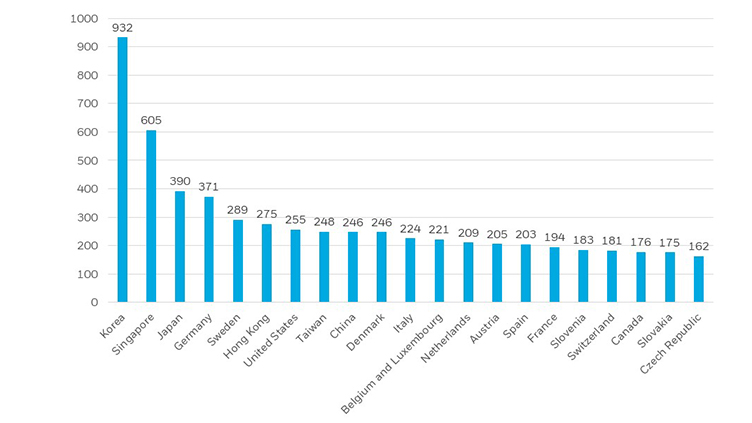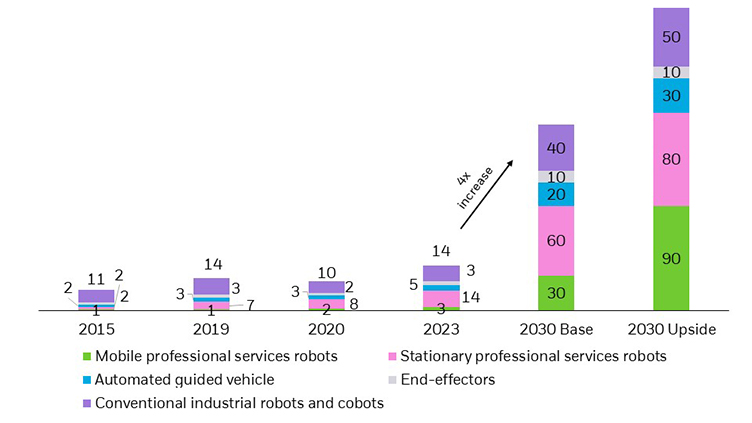KEY TAKEAWAYS:
- Robots have existed for decades; however recent technological breakthroughs across areas such as sensors, 5G connectivity, cloud computing and artificial intelligence are massively accelerating capabilities and adoption
- Industrial manufacturing and logistics have led the way in robotics adoption – we believe there could be room for continued growth here alongside more nascent applications in healthcare and services
- Wage inflation, labor shortages, demographic trends and supply chain transformation are game-changing catalysts that may accelerate demand for years to come
- Investors seeking exposure to robotics may want to consider ETFs that target the robotics value chain, from companies developing enabling technologies to those manufacturing robots themselves

EXPLORING DEVELOPMENTS IN THE ROBOTICS SPACE
The word robot can be traced back to 1920, when Czech playwright Karl Capek introduced it in his hit play, “Rossum’s Universal Robots”, a show that depicted robots taking over the world.1 Despite Capek’s chilling vision (and countless of our favorite films that have followed on the same theme – from Metropolis to The Matrix), robots have coexisted alongside humans for decades without a cinematic uprising.
The first industrial robot was rolled out by General Motors in 1959; the robot, called “The Unimate”, was a hydraulic arm that performed repetitive tasks such as welding.2 Seven years later, friendly robots entered pop culture when “The Unimate” appeared on The Tonight Show with Johnny Carson to play golf. (Check out the clip!)
As technology has become more powerful, efficient, and cheaper, robots have become more ubiquitous. In fact, North America robot sales have reached record highs for three straight quarters.3 We’ve also seen a range of robots enter our day to day lives: they vacuum floors, mow lawns, craft the perfect cup of coffee and even provide companionship. (This author’s vacuum and mop are named Rick and Rachael – after the protagonists of Blade Runner – they both clean and provide companionship, but no clarity yet as to whether they dream of electric sheep.) While fear of a robotic takeover is understandable, their ascension is anything but a zero-sum game. In fact, automation is combating supply chain disruption and inflation, allowing employees to move faster and focus on higher-value tasks.
DEMAND: HOW ROBOTICS USE CASES ARE GROWING ACROSS INDUSTRIES
We see two key segments of the economy driving near-term robotics adoption: logistics and healthcare. As the expected wait time on e-commerce orders has shrunk from weeks to days to hours, companies must find safe, cost-effective ways to automate warehouses. 80% of warehouse operators agree they will have to rely upon more automation in the future.10 Today, robots are largely used to move inventory around the warehouse in an efficient and safe manner. These robots, known as AMRs (autonomous mobile robots), are like self-driving cars. Going forward, robots will be leveraged for “order picking,” which is the act of finding the item inside the warehouse and bringing it to the packing station. Humans are not particular good at order picking. Robots reduce warehouse error rates by up to 67%. Moreover, they help address warehouse injuries: today, over 200K non-fatal accidents per year in U.S warehouses cause pain and suffering for employees alongside financial costs for companies of over $84M per week.
Healthcare similarly could see more robotics, with increasing usage in surgery, nursing, and cleaning. Robot-assisted surgical procedures offer benefits to doctors and patients and tend to improve outcomes. Typically, a surgical robot will have one arm with a camera, giving the surgeon a view of the affected area at up to 10x magnification versus the human eye. A second robotic arm will hold surgical instruments, allowing a degree of precision and steadiness not possible with human hands – the smaller resulting incisions improve outcomes and shorten recovery times – reducing pain, blood loss and scarring.14 Robotic surgery has become particularly important for urological and gynecological procedures, which make up about half of robotic procedures today. Globally, about 3% of surgeries are performed robotically, leaving tremendous runway for growth.
Nursing robots are also seeing growing demand at a time when nursing shortages are dire, with 1.2m new registered nurses needed in the U.S. by 2030. Robots assist nurses by performing time-consuming tasks, such as medicine delivery, collecting lab samples and taking vital signs. The robotic nursing market is expected to grow more than 22% per year through 2026, reaching more than $2b in annual sales.
TECHNOLOGIES ENABLING THE ROBOTICS SPACE
Robotics sits at the intersection of several breakthrough technologies, such as sensors, 5G connectivity, cloud computing and artificial intelligence.
Sensors can be considered the eyes of robots, allowing them to assess the surrounding environment, including light, temperature, and proximity to other objects. As robots become more widely used outside of assembly lines, their ability to navigate unstructured, changing environments has become increasingly important. Lidar (light detection and ranging) technology, enabled by sensors, allows a robot to gather 3D imaging data for mapping and object classification purposes. Recently, we are seeing lidar systems with the capability to see more than 1000m into the distance, nearly 5x further than previous systems. This recent advancement has significant positive implications for autonomous robots, enhancing their ability to operate safely alongside humans.
Cloud computing and 5G connectivity are enabling robots to process and access more data. For robots to reach their full potential, they must be autonomous and able to be controlled from anywhere. The massive computing power required by sophisticated bots necessitates the cloud, as the physical hardware required to store data locally, inside the robot, would be impractical from a design and cost standpoint. The robot must then be able to “talk” with the cloud in real time, transferring large amounts of information with low latency, meaning 5G networks are enabling more data and capabilities. With 70% of warehouses constructed before the 21st century, warehouses must undertake significant spending on digital infrastructure to allow the fleets of robots to communicate. In fact, the industrial sector’s power use could grow more than 2x as fast as any other real estate sector in the coming decade.
Finally, progress across three types of artificial intelligence: machine learning, natural language processing (NLP) and conversational AI are the keys to unlocking sensors and connectivity’s true potential. Machine learning enables robots to use data gleaned from previous experiences to develop new capabilities and solve unique problems. Take Rick, the robotic vacuum cleaner: when he maps the apartment, he identifies troublesome areas, such as stairs and furniture, and then avoids them in future cleanings. NLP enables robots to understand human language and is leveraged across industries such as retail via touchless check-out kiosks or smart speakers in the home. Conversational AI is the more advanced version of NLP and enables robots to interact in a more human like fashion. For example, fast-food restaurants have leveraged conversational AI to greet customers, take orders and make menu suggestions. All these technological advances are arguably having their biggest impact in two key segments driving adoption: logistics and healthcare.

HOW TO INVEST IN ROBOTICS STOCKS
Investors looking to access robotics companies may want to consider ETFs that hold pure-play firms across the full value-chain of robotics, targeting both the robotic developers as well as the technology enablers:
Robotics developers: Companies that manufacture robots across a variety of end-uses including household, healthcare, and industrial robots.
Robotics enablers: Companies that specialize in developing technologies such as 3D modeling, machine vision and motion control that enable increasingly sophisticated robots.
CONCLUSION
100 years after the coining of the term "robot," technological breakthroughs, new use cases as well as economic and demographic forces are bringing science fiction more and more to life. In our view, people looking to invest in robotics may want to consider ETFs that provide exposure to pure-play stocks across the theme’s value chain.


